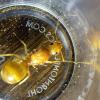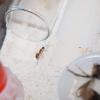While I’ve had this species for quite some time now, I haven’t considered writing a journal for them until now. This is also my first journal so here it goes.
It was September 15th of last year when I received the three queen colony of Acromyrmex from a friend who had caught them during nuptial flights. The colony was small, consisting of only a few larvae
and a small chunk of fungus in a Petri dish nest.

Care was straight forward and only required me to toss some leaves and oats into their outworld every once in a while, the ants did the rest of the work and fed their fungus as expected. Growth was smooth and the fungus steadily grew in size. The ants got their first worker on September 29th, only two weeks after receiving them.


October hit and the ants continued to produce workers and grow the fungus. On October third, two more nanitics eclosed, 9 days later, three more workers had eclosed, bringing the colony to a grand total of 6 workers. At this point the colony truly began to grow as the ants finally began foraging and harvesting leaves to bring back to the nest. The queens had laid a bunch of new eggs, and the next generation of workers was soon to eclose.

Unfortunately, this was when everything started to go downhill. The fungus began to die off and within only a few weeks the colony was basically fungusless.

Looking back on this moment makes me feel like a complete idiot since the entire situation was my fault and could have easily been avoided. It was as simple as me not knowing what wet hydrostone looked like, and letting the colony dry out to the extent that the fungus died off. I’m honestly quite lucky the ants didn’t die along with it since they must’ve been without an acceptable water source for days. Fortunately, the kind man I had gotten my Acromyrmex from had extra colonies in his care, so I received yet another Acromyrmex colony, determined to revive the colony that had been under my care for months. I didn’t know much at the time, but I did know that despite Acromyrmex versicolor’s monogynous tendencies, the Arizona populations were an exception, and could contain multiple queens without any problems. So on November 20th I proceeded to combine the two colonies. I first moved in the healthy fungus, then went on to dip the workers in vinegar to remove their scent. After about half an hour of no fighting, I moved in the queen and to my surprise, it worked. I now had a four queen colony of Acromyrmex versicolor.
Only four days later on the 24th of November, the colony began to grow again. The ants began placing fungus on the ceiling of the Petri dish, workers were constantly bringing in new leaves, the queens started laying eggs, and I made sure to water the nest properly.


After this the colony began to grow quite smoothly. I noticed that fungus growth and brood production slowed down a bit during the winter months but they got right back to work when February rolled around.


Fastforward to now, and the colony is doing amazing. They’ve stuffed the Petri dish full of fungus and brood, and have begun expanding into a shiny new Petri dish. This one is much larger and deeper than the one before so I’m expecting to see some cool hanging fungus structures. They’ve also been going through leaves surprisingly quick resulting in lots of new fungus growth in the dish. They’ve already begun building tiny fungus stalactites from the ceiling and have some small fungus balls growing from the ground. If they’ve accomplished all this within only 5 months, I’m really looking forward to where this colony will be at the end of the year.



Edited by SirDuckington, May 18 2021 - 5:25 PM.




























